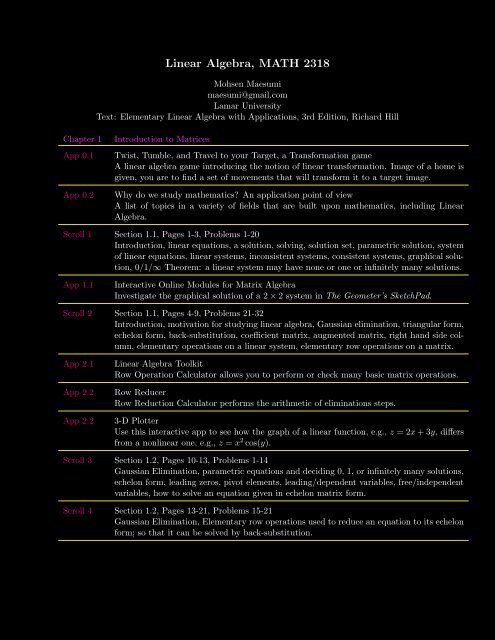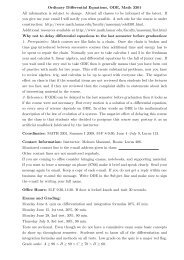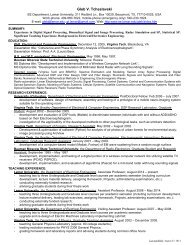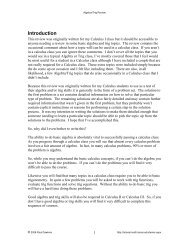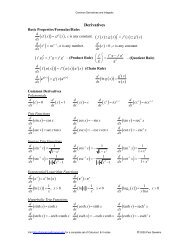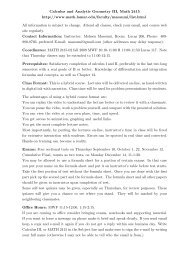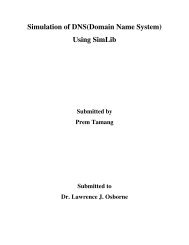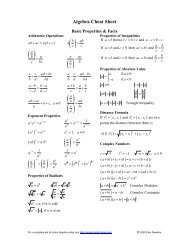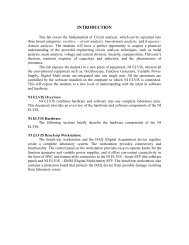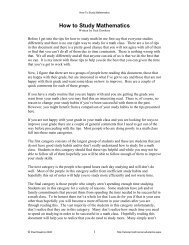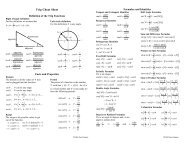Introduction to Linear Algebra, MATH 2318/3328 - Lamar University
Introduction to Linear Algebra, MATH 2318/3328 - Lamar University
Introduction to Linear Algebra, MATH 2318/3328 - Lamar University
You also want an ePaper? Increase the reach of your titles
YUMPU automatically turns print PDFs into web optimized ePapers that Google loves.
<strong>Linear</strong> <strong>Algebra</strong>, <strong>MATH</strong> <strong>2318</strong>Mohsen Maesumimaesumi@gmail.com<strong>Lamar</strong> <strong>University</strong>Text: Elementary <strong>Linear</strong> <strong>Algebra</strong> with Applications, 3rd Edition, Richard HillChapter 1App 0.1App 0.2<strong>Introduction</strong> <strong>to</strong> MatricesTwist, Tumble, and Travel <strong>to</strong> your Target, a Transformation gameA linear algebra game introducing the notion of linear transformation. Image of a home isgiven, you are <strong>to</strong> find a set of movements that will transform it <strong>to</strong> a target image.Why do we study mathematics? An application point of viewA list of <strong>to</strong>pics in a variety of fields that are built upon mathematics, including <strong>Linear</strong><strong>Algebra</strong>.Scroll 1 Section 1.1, Pages 1-3, Problems 1-20<strong>Introduction</strong>, linear equations, a solution, solving, solution set, parametric solution, systemof linear equations, linear systems, inconsistent systems, consistent systems, graphical solution,0/1/∞ Theorem: a linear system may have none or one or infinitely many solutions.App 1.1Interactive Online Modules for Matrix <strong>Algebra</strong>Investigate the graphical solution of a 2 × 2 system in The Geometer’s SketchPad.Scroll 2 Section 1.1, Pages 4-9, Problems 21-32<strong>Introduction</strong>, motivation for studying linear algebra, Gaussian elimination, triangular form,echelon form, back-substitution, coefficient matrix, augmented matrix, right hand side column,elementary operations on a linear system, elementary row operations on a matrix.App 2.1App 2.2App 2.2<strong>Linear</strong> <strong>Algebra</strong> ToolkitRow Operation Calcula<strong>to</strong>r allows you <strong>to</strong> perform or check many basic matrix operations.Row ReducerRow Reduction Calcula<strong>to</strong>r performs the arithmetic of eliminations steps.3-D PlotterUse this interactive app <strong>to</strong> see how the graph of a linear function, e.g., z = 2x + 3y, differsfrom a nonlinear one, e.g., z = x 2 cos(y).Scroll 3 Section 1.2, Pages 10-13, Problems 1-14Gaussian Elimination, parametric equations and deciding 0, 1, or infinitely many solutions,echelon form, leading zeros, pivot elements, leading/dependent variables, free/independentvariables, how <strong>to</strong> solve an equation given in echelon matrix form.Scroll 4 Section 1.2, Pages 13-21, Problems 15-21Gaussian Elimination, Elementary row operations used <strong>to</strong> reduce an equation <strong>to</strong> its echelonform; so that it can be solved by back-substitution.1
Chapter 1<strong>Introduction</strong> <strong>to</strong> MatricesScroll 5 Section 1.3, Pages 23-27, Problems 1-14Problem 15 from 1.2, matrix entry or element, matrix size or dimension, double subscript,matrix addition and subtraction, scalars and matrices, multiplication of a scalar and amatrix, dot product or inner product, matrix product as a collection of dot products.App 5.1App 5.2App 5.3Matrix Calcula<strong>to</strong>rUse this calcula<strong>to</strong>r <strong>to</strong> check your multiplications.Interactive Online Modules for Matrix <strong>Algebra</strong>A visual demo of multiplication of 2 × 2 matrices.Wolfram Demonstrations ProjectSee how matrix product is constructed from the dot product of rows and columns.Scroll 6 Section 1.3, Pages 27-29, Problems 15-16Matrix product as a collection of dot products, general formula using summation notation.Scroll 7 Section 1.3, Pages 30-31, Problems 21-32Interpretations of matrix multiplication, multiplication by a diagonal matrix, a linear systemwritten as matrix product, substitution as matrix multiplication, matrix multiplication asa sum of products of columns with rows.Scroll 8 Section 1.3, Pages 32-34, Problems 33-42, Section 1.4, Pages 38-39Different styles for matrix multiplication, interpretations of AB in terms of (a) dot productsof rows of A with columns of B, (b) matrix A with columns of B, (c) rows of A with matrixB, (d) row matrices of A with column matrices of B, (e) sum of outer products of columnsof A with corresponding rows of B, and (f) AX, with X a vec<strong>to</strong>r, as the linear combinationof columns of A with weights same as entries of vec<strong>to</strong>r X.Scroll 9 Section 1.4, Pages 38-45, Problems 1-14Inverses and elementary matrices, the elementary matrix associated with multiplication ofa row and exchange of two rows.Scroll 10 Section 1.4, Pages 38-45, Problems 15-24, 36, 39, 40-43, 45, 49, 50Inverses and elementary matrices Elementary column operations (related <strong>to</strong> problem 50).Problem 37 from 1.3. Different styles (row expansion, column expansion, outer productexpansion) for multiplication of matrices, related <strong>to</strong> lecture 8. Elementary matrix associatedwith adding multiple of a row <strong>to</strong> another row. General procedure for finding the inverse.Scroll 11 Section 1.4, Pages 48-49, Problems 9-20, 25-45Finding Inverses using elementary matrices An example of 3 × 3 matrix being inverted. Ashort discussion of non-invertible matricesScroll 12 Section 1.5, Pages 57-62, Problems 1-8LU fac<strong>to</strong>rization for a simple case (without permutation), description of algorithm andjustification of procedure.Scroll 13 Section 1.5, Pages 62-64, Problems 9-24Solving AX = B via LU fac<strong>to</strong>rization, advantages of LU fac<strong>to</strong>rization, solving systems withfac<strong>to</strong>rization, general permutation matrices, P A = LU fac<strong>to</strong>rization.2Scroll 14 Section 1.5, Pages 64-67, Problems 33-36, Section 1.6 Pages 71-72, Problems 1-7, 13, 14,19,20, Section 3.1 Pages 130-131Solving AX = B via P A = LU fac<strong>to</strong>rization, an example, symmetric, skew-symmetricmatrices, determinants of 2 × 2 and 3 × 3 matrices, vec<strong>to</strong>rs in physics
Chapter 3Scroll 15Vec<strong>to</strong>rsSection 3.1, Pages 132-137, 151, Problems 1-30 with the exclusion of span questionsVec<strong>to</strong>rs, scalars, vec<strong>to</strong>rs, matrices, graphical addition, subtraction, and scalar multiplicationof vec<strong>to</strong>rsScroll 16 Section 3.1, Pages 137-141, Problems 1-30Norm(length, size, magnitude) of a vec<strong>to</strong>r, distance formula, dot product of vec<strong>to</strong>rs, anglebetween vec<strong>to</strong>rs, length in terms of dot product, dot product in terms of components,example: find the angle between two vec<strong>to</strong>rs.Scroll 17 Section 3.1, Pages 140-144, Problems 31-42Dot Product theorem, projections, Problems 5, 11, 36. Proof of Law of Cosines, Proof ofU · V = u 1 v 1 + u 2 v 2 + u 3 v 3 = |U||V| cos θ.Scroll 18 Section 3.1, Pages 144-146, Problems 43-50Gram-Schmidt Process, Problem 21, producing a set of mutually perpendicular vec<strong>to</strong>rs P iout of an arbitrary vec<strong>to</strong>rs V i using projections.Scroll 19Section 3.2, 3.3 Pages 149-165, Problems allEuclidean n-Space, General Vec<strong>to</strong>r Spaces, Closure.Scroll 20 Review Sections, 1.4,1.5,1.6, 3.1,3.2Inverse, LU fac<strong>to</strong>rization.App 3.1Interactive Online Modules for Matrix <strong>Algebra</strong>Learn about the linear combination, span, and linear independence by following the demounder Vec<strong>to</strong>r Spaces (third row, under construction).Scroll 21 Section 3.4 Pages 165-169, Problems 1-24Subspaces, closure with respect <strong>to</strong> vec<strong>to</strong>r addition and scalar multiplication, span.Scroll 22 Section 3.4 Pages 165-169, Problems 1-24Examples of subspaces.Scroll 23 Section 3.4 Pages 169-173, Problems 33-40Subspaces, null spaces, NS(A), linear combinations.Scroll 24 Section 3.4, Pages 173-176,Section 3.5, Pages 179-180Subspaces, linear combinations, in AX = B vec<strong>to</strong>r B is a linear of columns of A with weightfac<strong>to</strong>r X , linear dependence and independenceScroll 25 Section 3.5, Pages 179-180<strong>Linear</strong> Independence, Problems 29 and 38 from 3.4.Scroll 26 Section 3.5, Pages 180-185<strong>Linear</strong> independence and dependence.Scroll 27 Section 3.6, Pages 187-192, Problems 1-20Basis, given a set of vec<strong>to</strong>rs how do we detect if they form a basis for a given space?3
Chapter 5Eigenvalues, Eigenvec<strong>to</strong>rs, and EigenspacesScroll 28 Section 5.1, Pages 320-326, Problems 1-20Determinants, brief review, short cuts, expansion/recursive formulaScroll 29 Section 5.1, Pages 326-329, Problems 21-39Determinants, three theoremsScroll 30App 30.1App 30.2App 30.3App 30.4Scroll 31Section 5.2, Pages 331-334, Problems 1-9, 11-22 (part b only)<strong>Introduction</strong> <strong>to</strong> eigenvalues and eigenvec<strong>to</strong>rsInteractive Online Modules for Matrix <strong>Algebra</strong>Visual description of input and output vec<strong>to</strong>rs, eigenvalues and eigen vec<strong>to</strong>rs.Interactive Mathematics ProjectDemo 1 gives a visual description of eigenvec<strong>to</strong>rs and eigenvalues.Several videos for various cases of eigenvalues and eigenvec<strong>to</strong>rs.Wolfram Demonstrations ProjectVisual and experimental way of finding eigenvec<strong>to</strong>rs and eigenvalues.Section 5.2, Pages 331-335, Problems 11-22 (parts a, b only)Eigenvalues (real, complex, double), characteristic polynomial of a matrix.Scroll 32 Section 5.2, Pages 331-335, Problems 11-22 (parts a, b, c)Finding eigenvec<strong>to</strong>rs of a matrix, matrix fac<strong>to</strong>rization in<strong>to</strong> eigenvec<strong>to</strong>r matrix × eigenvaluematrix × inverse of eigenvec<strong>to</strong>r matrix, A = V ΛV −1Scroll 33 Section 5.2, Pages 331-335, Problems 18-2Finding eigenvec<strong>to</strong>rs of a 3 × 3 matrixScroll 34 Section 5.2, Pages 331-335, Problems 17-22Diagonalization, V −1 AV = Λ, example of a 3 × 3 matrixScroll 35 Section 5.2, Pages 331-335, Problems 17-22Repeated eigenvalues, finding eigenvec<strong>to</strong>rs and basis of eigenspaces for repeated roots ofcharacteristic polynomial, several examplesScroll 36Section 5.2, Pages 338-339,, Problems 11-22 (part f),Section 5.3, Pages 342-349, Problems 1-26Sum of eigenvalues=trace, product of eigenvalues=determinant, functions of a matrix,f(A) = V f(λ)V −1 , diagonalizability.Scroll 37 Section 5.3, Pages 342-349, Problems 1-26Diagonalization, non-diagonalizable matricesScroll 38 Section 5.4, Pages 352-358, Problems 1-9Symmetric Matrices, properties, orthogonal (orthonormal) matrices, Theorem: Eigenvaluesof a real symmetric 2 × 2 matrix are real.Scroll 39 Section 5.4, Pages 352-358, Problems 1-9Review of symmetric matrices , Problem 1Scroll 40 Sections 5.2, 5.3, 5.64Eigenvalues, eigenvec<strong>to</strong>rs, diagonalization, a system of differential equationsScroll 41 Sections 5.5, Pages 352-358Markov processes


